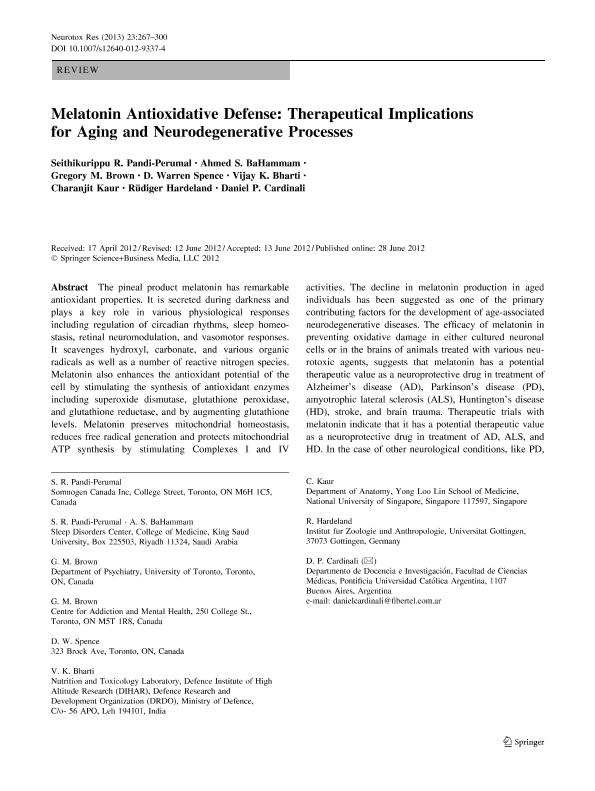Mostrar el registro sencillo del ítem
dc.contributor.author
Pandi Perumal, Seithikurippu R.
dc.contributor.author
BaHammam, Ahmed S.
dc.contributor.author
Brown, Gregory M.
dc.contributor.author
Spence, D. Warren
dc.contributor.author
Bharti, Vijay K.
dc.contributor.author
Kaur, Charanjit
dc.contributor.author
Hardeland, Rüdiger
dc.contributor.author
Cardinali, Daniel Pedro

dc.date.available
2016-01-27T20:02:42Z
dc.date.issued
2013-04
dc.identifier.citation
Pandi Perumal, Seithikurippu R.; BaHammam, Ahmed S.; Brown, Gregory M.; Spence, D. Warren; Bharti, Vijay K.; et al.; Melatonin antioxidative defense: therapeutical implications for aging and neurodegenerative processes; Springer; Neurotoxicity Research; 23; 3; 4-2013; 267-300
dc.identifier.issn
1029-8428
dc.identifier.uri
http://hdl.handle.net/11336/3859
dc.description.abstract
The pineal product melatonin has remarkable antioxidant properties. It is secreted during darkness and plays a key role in various physiological responses including regulation of circadian rhythms, sleep homeostasis, retinal neuromodulation, and vasomotor responses. It scavenges hydroxyl, carbonate, and various organic radicals as well as a number of reactive nitrogen species. Melatonin also enhances the antioxidant potential of the cell by stimulating the synthesis of antioxidant enzymes including superoxide dismutase, glutathione peroxidase, and glutathione reductase, and by augmenting glutathione levels. Melatonin preserves mitochondrial homeostasis, reduces free radical generation and protects mitochondrial ATP synthesis by stimulating Complexes I and IV activities. The decline in melatonin production in aged individuals has been suggested as one of the primary contributing factors for the development of age-associated neurodegenerative diseases. The efficacy of melatonin in preventing oxidative damage in either cultured neuronal cells or in the brains of animals treated with various neurotoxic agents, suggests that melatonin has a potential therapeutic value as a neuroprotective drug in treatment of Alzheimer’s disease (AD), Parkinson’s disease (PD), amyotrophic lateral sclerosis (ALS), Huntington’s disease (HD), stroke, and brain trauma. Therapeutic trials with melatonin indicate that it has a potential therapeutic value as a neuroprotective drug in treatment of AD, ALS, and HD. In the case of other neurological conditions, like PD, the evidence is less compelling. Melatonin’s efficacy in combating free radical damage in the brain suggests that it can be a valuable therapeutic agent in the treatment of cerebral edema following traumatic brain injury or stroke. Clinical trials employing melatonin doses in the range of 50–100 mg/day are warranted before its relative merits as a neuroprotective agent is definitively established.
dc.format
application/pdf
dc.language.iso
eng
dc.publisher
Springer

dc.rights
info:eu-repo/semantics/openAccess
dc.rights.uri
https://creativecommons.org/licenses/by-nc-sa/2.5/ar/
dc.subject
Melatonin
dc.subject
Mitochondria
dc.subject
Free Radicals
dc.subject
Oxidative Stress
dc.subject
Aging
dc.subject
Parkinson´S Disease
dc.subject
Alzheimer´S Disease
dc.subject
Huntington´S Disease
dc.subject
Amyotrophic Lateral Sclerosis
dc.subject
Stroke
dc.subject.classification
Neurociencias

dc.subject.classification
Medicina Básica

dc.subject.classification
CIENCIAS MÉDICAS Y DE LA SALUD

dc.subject.classification
Neurología Clínica

dc.subject.classification
Medicina Clínica

dc.subject.classification
CIENCIAS MÉDICAS Y DE LA SALUD

dc.title
Melatonin antioxidative defense: therapeutical implications for aging and neurodegenerative processes
dc.type
info:eu-repo/semantics/article
dc.type
info:ar-repo/semantics/artículo
dc.type
info:eu-repo/semantics/publishedVersion
dc.date.updated
2016-03-30 10:35:44.97925-03
dc.journal.volume
23
dc.journal.number
3
dc.journal.pagination
267-300
dc.journal.pais
Alemania

dc.journal.ciudad
Berlin
dc.description.fil
Fil: Pandi Perumal, Seithikurippu R.. Somnogen Canada Inc.; Canadá. King Saud University. College of Medicine. Sleep Disorders Center; Arabia Saudita
dc.description.fil
Fil: BaHammam, Ahmed S.. King Saud University. College of Medicine. Sleep Disorders Center; Arabia Saudita
dc.description.fil
Fil: Brown, Gregory M.. University of Toronto. Department of Psychiatry; Canadá. Centre for Addiction and Mental Health; Canadá
dc.description.fil
Fil: Spence, D. Warren.
dc.description.fil
Fil: Bharti, Vijay K.. Ministry of Defence. Defence Research and
Development Organization. Defence Institute of High Altitude Research. Nutrition and Toxicology Laboratory; India
dc.description.fil
Fil: Kaur, Charanjit. National University of Singapore. Yong Loo Lin School of Medicine. Department of Anatomy; Singapur
dc.description.fil
Fil: Hardeland, Rüdiger. Universitat Gottingen. Institut fur Zoologie und Anthropologie; Alemania
dc.description.fil
Fil: Cardinali, Daniel Pedro. Pontificia Universidad Católica Argentina "Santa María de los Buenos Aires". Facultad de Ciencias Médicas; Argentina. Consejo Nacional de Investigaciones Científicas y Técnicas; Argentina
dc.journal.title
Neurotoxicity Research

dc.relation.alternativeid
info:eu-repo/semantics/altIdentifier/url/http://link.springer.com/article/10.1007%2Fs12640-012-9337-4
dc.relation.alternativeid
info:eu-repo/semantics/altIdentifier/doi/http://dx.doi.org/10.1007/s12640-012-9337-4
dc.relation.alternativeid
info:eu-repo/semantics/altIdentifier/issn/1029-8428
Archivos asociados
